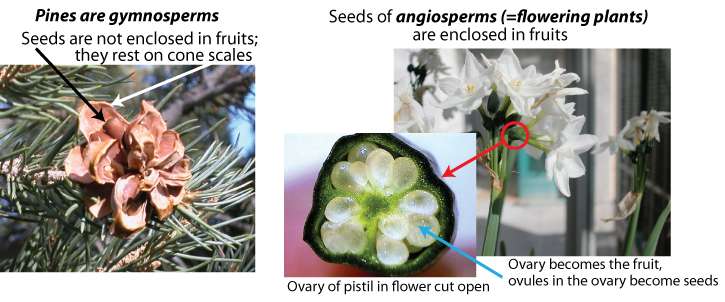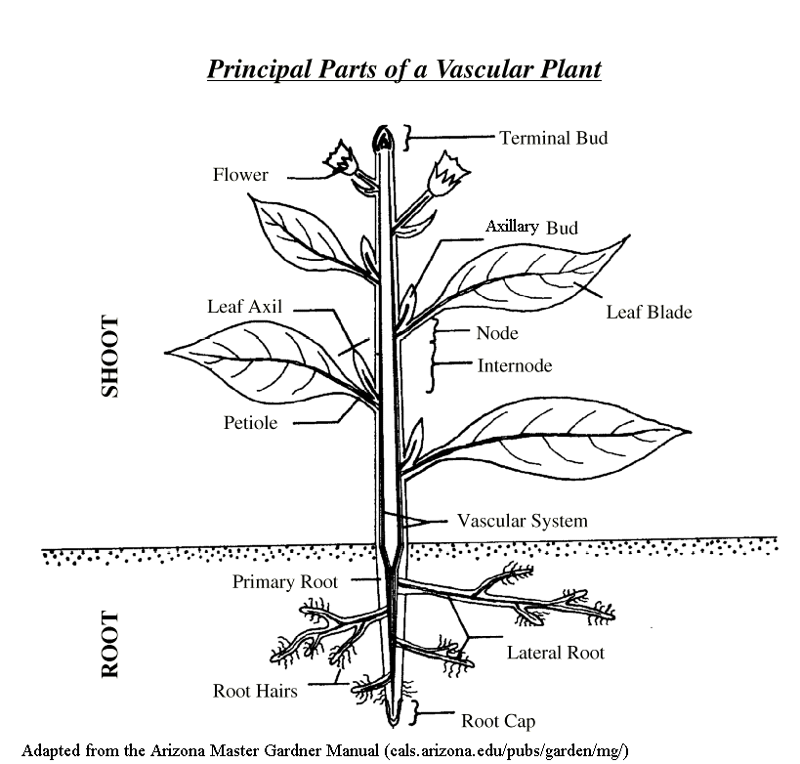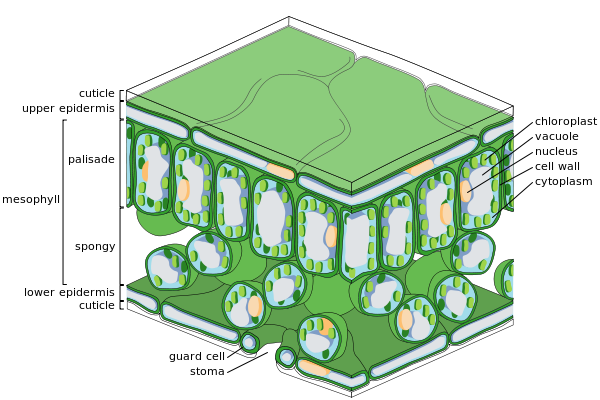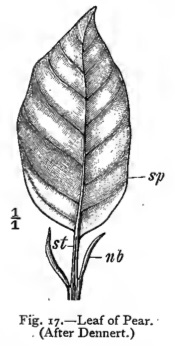
Plant Biology Basics
Basic Plant Biology
[Notes: Hyperlinks will open external links in new browser tabs or windows.]
There is a wide variety of plant species in the world.
Some produce seeds; others (like ferns) do not. Ferns release single-celled spores, not multi-celled seeds.
Plant species that produce seeds can be classified as flowering plants (plants that produce flowers and whose seeds are enclosed in fruits) or gymnosperms (which means "naked seeds", whose seeds are not enclosed in any structure).

A general life cycle of a flowering plant is shown at http://theseedsite.co.uk/lifecycle.html. This link will open in a separate window or tab. Look at the steps in this life cycle and read the descriptions of different types of plant life cycles at the bottom of the page.
Note that this life cycle shown the plant dying before its seeds germinate to form new plants. Would all plants die before their seeds germinate?
All plants have roots, that are usually belowground, and shoots, that are usually aboveground and include stems, leaves, and (sometimes) flowers.
Below is a good diagram of basic plant structure, adapted from the Arizona Master Gardner Manual (produced by the Cooperative Extension, College of Agriculture, University of Arizona, http://ag.arizona.edu/pubs/garden/mg/botany/plantparts.html). I have revised the image slightly by changing one label to read "Axillary bud".
At the tip of the stem is the terminal bud. This is where growth occurs, producing new leaves and new stem tissue.
Sections of stem that are left behind as the stem tip elongates may be classified as nodes (sections of stem to which leaves are attached) and internodes (the regions between the nodes). Nodes may or may not be swollen.
Leaves may have two distinct parts: the flat blade and a stalk called the petiole. The thin, flat shape of most leaves maximizes surface area for absorbing light and carbon dioxide for photosynthesis. Variations in leaf structure are discussed below.
The upper angle between the leaf and the stem is called the leaf "axil". Think of the axil as an upside-down armpit. In that axil is an axillary bud. An axillary bud is just like a terminal bud. It may grow out to produce a branch, which has all the same parts as the main stem (nodes, internodes, leaves, etc.). It may grow out to produce a flower, or it may never grow.
We will discuss flower structure in a later lesson.
Roots have root caps at their tips: a cap of tissue that protects the tender, growing young tissue as it pushes through the soil. Roots produce root hairs a short distance behind the root tip. These are hair-like extensions of single cells that increase the surface area of the root for absorbing minerals and water. Lateral roots that grow out from the primary root have the same parts as the first, or primary, root.
This diagram also shows internal vascular tissues. Briefly, plants have two types of vascular tissues inside them: xylem, which transports water and any minerals dissolved in water, and phloem, which transports sugar. Xylem contains chains of dead cells with stiff cell walls that act as pipes or soda straws, allowing water to be drawn up the plant from the soil as water evaporates from the leaves. This is very similar to the way in which liquid is sucked up a soda straw. The mechanism driving sugar transport in the phloem is more complex. Suffice it to say that the phloem can transport a sugar solution from leaves, where sugars are produced by photosynthesis, to anywhere in the plant where sugars are needed to provide energy or materials to grow new plant tissue. It also can transport sugars from storage organs (like swollen underground stems or roots), where carbohydrates are stored as starch for later use, to places in the plant where energy and/or carbon is needed to grow or maintain plant tissue.
The primary function of a leaf is to photosynthesize.
The internal anatomy of a leaf is not addressed at the K-5 level. However, understanding it is important when one has to understand concepts like plant competition (especially competition for water), adaptations that help plants deal with different environmental conditions (especially drought and heat), and other real-world issues that are part of the K-5 curriculum. Here is is in a nutshell:

1) Leaves are covered with a waxy layer called a cuticle to retard water loss. This also blocks carbon dioxide uptake.
2) Carbon dioxide has to get into the leaf and dissolve in the water of the wet cell walls inside the leaf before it can be taken into the photosynthetic cells and used in photosynthesis.
3) Pores in the epidermis called stomata (singular: stoma or stomate, meaning "mouth") can open and close, restricting or allowing carbon dioxide uptake and water vapor loss.
4) Most of the water taken up by a plant is lost to evaporation from leaves as they open their stomata to obtain carbon dioxide.
5) [Relevant to later discussions of leaf adaptation]: a hot leaf will lose water more quickly than a cool leaf if they have the same number of stomata open the same amount. Why? Hot water evaporates quicker than cool water.
The diagram above is from Wikimedia Commons (author: Zephyris; url: http://en.wikipedia.org/wiki/Epidermis_%28botany%29#mediaviewer/File:Leaf_Tissue_Structure.svgz)
 Basic parts of a leaf are the blade, the petiole (stalk of the leaf), and stipules (two structures at the base of the leaf or flanking it).
Basic parts of a leaf are the blade, the petiole (stalk of the leaf), and stipules (two structures at the base of the leaf or flanking it).
Some leaves do not have petioles: they are called sessile leaves.
Many species do not produced stipules. Stipules may vary widely among species that do produce stipules. In some species, stipules are small and fragile. In others, they are large and leaf- like. In yet others, they are hard little knobs, and in some they form thorns.
Some are simple leaves, with a single expanse of blade; others are compound leaves, with many separate little blades or leaflets. How can you tell if you are looking at a lot of little leaves or a lot of little leaflets on a single leaf? Look for the axillary bud. There should be an axillary bud in the axil of each leaf. View the University of Wisconsin's explanation of how to distinguish a compound leaf from a simple leaf at the following website: https://www.uwgb.edu/biodiversity/herbarium/trees/simple_compound_leaves01.htm . (This link opens in a separate tab or window.)
The drawings below show five leaves. Which is a compound leaf?
Some leaves live only a few weeks; others live for decades.
Deciduous leaves are leaves that all fall from the plant seasonally. Winter-deciduous plants are leafless during the winter. Drought-deciduous plants are leafless during the dry season.
Evergreen leaves typically live more than one year, resulting in a plant that is never leafless. (Note that you can have an evergreen plant with short-lived leaves, as long as leaves continually produced and always present on the plant.)
[More detail on different leaf shapes, characteristics that are important in identifying plants, will be covered in a later lesson.]
Stems hold up leaves. Why might that be important to a plant?
Stems hold up flowers. Why might that be important to a plant?
Stems transport water from the soil to the leaves, and transport sugars from the leaves to the roots (...or [advanced topic alert:] from where they have been stored as starch in a storage organ like a potato or storage root to where they are needed, like regrowing leaves and branches after the winter or after a fire, or after an animal has eaten them.).
Some stems do not grow upright and tall. You can still tell they are stems, instead of roots, because they have nodes with (sometimes tiny) leaves and axillary buds.
Some of these modified stems are underground and horizontal. These types of stems are called rhizomes.
Some of these modified stems are short, fat and underground. These are called tubers. A potato is an example of a tuber.
View a description and drawings of different modified stems at http://theseedsite.co.uk/bulbs.html. Learn these, then complete the activity below.
The basic functions of roots are to (1) anchor the plant to the soil, (2) help support the shoot (so it doesn't fall over), and (3) absorb water and mineral nutrients from the soil.
In some plants, however, the primary root or tap root thickens into a storage organ, where it stores energy in the form of starch.
All plants grow from the tips of stems and roots. This type of growth causes stems and roots to elongate. This also causes new leaves to be produced at the tip of the stem as the plant grows. This is called primary growth.
[Advanced topic alert: you will not be explaining cells to K-5 students]: Terminal buds, axillary buds, and the tips of roots contain "apical meristems", balls of cells whose sole purpose is to divide to produce new cells. When these cells divide, some of the daugher cells remain in the meristem and others (the ones away from the tip), elongate and become new cells of the root or shoot. The apical meristems at the root tip are protected by a root cap; The apical meristems at the tips of stems and in the axils of leaves are often protected by small leaves. The terminal and axillary "buds" of the shoot include the apical merstems and their small leaves.
A time-lapse video of a shoot growing and producing new leaves can be found online at the University of Indiana's "Plants in Motion" website. A link to this video (http://plantsinmotion.bio.indiana.edu/plantmotion/vegetative/veg.html) will open in a new window. Select "rosette growth" to view stem growth and leaf production. If you have a very slow internet connection, you may not want to try this at home. This "Plants in Motion" website, by Dr. Roger Hangarter, has some excellent time-lapse videos showing growth, germination, and responses to the environment. It can be found at http://plantsinmotion.bio.indiana.edu.
Very early growth of a seedling will be discussed below, when we explore the parts of the seed and the process of seed germination.
Some plants become thick and woody. These plants increase in girth, or thicken, by using a different type of meristem, a sheet of meristematic cells that exists between the bark and the wood. This layer is called the vascular cambium. It produces new xylem (water-conducting tissue, which is the wood) to the inside, and new phloem ("food"-conducting tissue, contained in the bark) to the outside. A labeled picture of these zones can be found at http://botit.botany.wisc.edu/Resources/Botany/Secondary%20Growth/Stem/Woody%20Section/Inner%20outer%20bark.jpg.html
If you strip the bark off a tree, the bark will peel off right at the vascular cambium. However, since the sugar-conducting (or "food"-conducting tissue) is in the inner bark, if you remove all of the bark around a tree, what will probably happen to the tree?
Herbaceous plants are plants that are not woody. Most annual plants remain herbaceous throughout their lives. Some perennials have shoots that die back to the ground each year: their roots live year-round, but they put up new shoots every year. These shoots often remain herbaceous, the plant is referred to as an "herbaceous perennial. [Note: The Jepson Manual reserves the abbreviation "per." (meaning "perennial") for herbaceous perennials.] Some herbaceous plants do not support themselves without using another structure for support; those are vines.
Woody plants may be referred to as...
The Arizona Master Gardner Manual (produced by the Cooperative Extension, College of Agriculture, University of Arizona) is a good resource with lots of basic and applied information. You just need to remember that we are not in Arizona, and that their desert gets a bit more summer, monsoonal rainfall than the areas around San Bernardino and Victorville.
A complete flower has four types of parts.
[Variation in flower structure will be covered in greater detail in a later lesson.]
The pollen grain is a small multi-cellular structure that carries the sperm of the plant.
The ovules, little balls inside an ovary of a pistil, are very complex little structures that contain eggs.
Pollination is the transfer of the pollen grain from the anther of a flower to the stigma of a pistil.
Fertilization is the joining of the sperm (carried by the pollen grain) to an egg (contained in an ovule). To get the sperm from the pollen grain on a stigma to an egg in an ovule, a pollen grain grows a long pollen tube down the style of a pistil until it reaches an ovule, where it delivers sperm to the egg in the ovule.
Plants often use animals to pollinate their flowers. Some species do not. Oak trees and grass species are examples of plants whose flowers do not have colorful petals (or any petals), and rely on wind to carry their pollen.
Some plants (not all) have traits that encourage transfer of pollen from one flower to another (rather from the anthers of a flower to the pistil of the same flower).
In some cases, the pistil and anthers mature at different times, preventing self-pollination.
In some cases, the flower is constructed to avoid pollinating its own flower. Video clips of changes in a passion flower and a discussion of how these changes discourage self-pollination may be viewed on the Plants in Motion website: http://plantsinmotion.bio.indiana.edu/plantmotion/flowers/passionflower/passion.html
Monkey flowers, many of which are native to southern California, have flat, sensitive stigmas that close after being touched. Below is a video clip of this phenomenon from YouTube (http://youtu.be/O2RPIMoz7Mg). Speculate on how this action affects self-pollination.
Not all flowers prevent self-fertilization. Sometimes self-fertilization is beneficial, allowing a plant to produce seed even when it is the only member of its species within a hundred miles.
Some plant species (not all) require very specific pollinators to carry their pollen from one plant to another. This can create major conservation problems and/or economic problems when pollinators go extinct or disappear from an area. Hand-pollination is a common practice for increasing seed production of rare plant species, especially ones with low or no seed production in the wild.
After the egg in an ovule is fertilized...
...the ovule eventually becomes a seed,
...the fertilized egg [the zygote, a term you might not use] grows into the embryo (baby plant) inside the seed, and
...the ovary that contained the ovule(s) becomes the fruit that contains the seed(s)
In general, the function of fruits is to help disperse seeds (spread them away from the parent plant).
[Reflect: Compare a plant that disperses its seed away from itself to a plant that does not, and drops its seed directly at the base of its stem. Which plant's offspring would likely grow best? Which plant's descendents would be more widespread after a few generations?]
Fruits may be sweet and juicy, and attract animals to eat the fruit and scatter the seed.
Fruits may be dry and prickly or sticky, and use animals for dispersal by sticking to their fur or socks.
Fruits may mechanically eject seeds, squirting them or flinging them as the fruit splits.
Some fruits have wings or parachute-like structures to help them sail away on the wind.
[Note that the seeds, themselves, may have barbs, parachutes, wings, fleshy attachments, and other features that help in their own dispersal. You should be able to distinguish a fruit from a seed so that if a bright student asks "So where is the fruit on this plant?", you know.]
Videos of squirting cucumbers, exposive dehiscence, wind dispersal, and other methods of dispersal are available on the web. Examples:
http://www.gettyimages.com/detail/video/squirting-cucumbers-squirt-seeds-out-using-water-stock-video-footage/1B0725_0011
http://www.gettyimages.com/detail/video/willowherb-seed-pod-bursting-and-dispersing-in-stock-video-footage/142426023
http://www.gettyimages.com/detail/video/high-speed-exploding-himalayan-balsam-pods-stock-video-footage/143278384
http://www.gettyimages.com/detail/video/common-dandelion-taraxacum-officinale-seeds-from-stock-video-footage/138145753
Although there are many technical terms for different types of fruits, you should recognize two categories of fruits:
(1) fruits that contain several seeds and split to release those seeds when the seeds are mature, vs.
(2) fruits that contain only one seed and do not release the seed. Species that have this type of fruit, disperse the entire fruit, rather than dispersing the seeds from the fruit. Acorns, sunflower "seeds", and grass "seeds" are examples of this type of fruit. When the seeds of these species germinate, the embryo has to grow through both the seed coat and the fruit wall.
[Different types of fruits will be discussed in greater detail in a later lesson.]
The outer layer of the seed is called the seed coat.
Inside the seed is an embryo and a food supply for the embryo. Good diagrams of the parts of a seed and the parts of the embryo can be found in the Arizona Master Gardner's Manual (below; at http://ag.arizona.edu/pubs/garden/mg/botany/seeds.html). The embryo has a young root (often called a "radicle", a shoot tip with young leaves (often called a "plumule", because it looks like a bunch of little feathers or plumes), one or two cotyledons (also called seed leaves). The section of the seedling axis just below the cotyledons is called the "hypocotyl" ("hypo" meaning "below'), and the section of the seedling axis just above the seedling axis is called the "epicotyl" ("epi" meaning "on top of"). New roots and new shoots with leaves will be produced throughout the life of the plant. However, the cotyledons, the epicotyl, and the hypocotyl are only produced once: in the embryo.
Note that in some seeds, like the seeds of beans and peas, there is no endosperm in a mature seed. During development, the embryo has absorbed all of the "food", or endosperm, into its body and stored it in its cotyledons (or "seed leaves"). Other seeds, like the pepper and tobacco seeds still have a food supply outside the embryo when the seed is mature.
When a seed absorbs water, it may germinate. Seeds also need favorable temperatures and oxygen to germinate; they need energy to grow, and they burn a lot of "food" to get that energy. (You can say that seeds sprout, but using the term "sprout" to refer to germination can get confusing: we also say that stems resprout from the top of the root when talking about the way some plants recover from fire, we talk about potatoes sprouting, and we talk about new branches sprouting from the trunk of a tree, etc. If you are discussing different ways plants react to the environment, using a general term like "sprout" to refer to different processes can really confuse the discussion.)
Some seeds also need light to germinate; some require darkness. Exposure to light tells a seed it is close to the soil surface. Being in the dark tells the seed it is well buried. Some plants need other treatments or signals from the environment before they will germinate. Some plants need several weeks of cold, moist conditons; some need exposure to smoke; some need exposure to heat, and some need exposure to either acid or something abrasive that weakens their seed coat. Most of these signals tell a seed that it is now in a time or place that is favorable for seedling survival. Having experienced cold, moist conditions tells the seed that it has gone through a winter, and it is probably spring. Exposure to smoke or heat tells the seed that their has been a fire, and that most of the large, competing, adult plants aren't so large and competitive anymore. Exposure to acid tells the seed that it has passed through the gut of an animal, and that it has probably now been dispersed well away from the parent plant. (Stomach acid is very acidic...it "burns" when you throw up.) Seeds that require acid, heat, or abrasion to germinate have hard seed coats that prevent the seed from absorbing water until they are weakened.
All seeds need water, oxygen, and favorable temperatures to germinate. Those that require special, additional conditions to germinate may lie dormant, or sleeping, in the soil until they receive those cues. Some species do not produced dormant seeds, some produce seeds that can lie dormant for 2-3 years before they die, and others produce seeds that can lie dormant for many decades before they die.
Seed germination begins with the seed absorbing water, swelling, and growing its root (called the "radicle" in the embryo) out into the soil. Next, either the hypocotyl (the section of the seedling axis under the cotyledons), or the epicotyl (the section of the seedling axis above the cotyledons) elongates. What happens to the cotyledons when this happens?
After epicotyl or hypocotyl elongation, the root and shoot grow from the tips, as they do in an adult plant.
One of the videos from the Plants in Motion website, shows corn germinating. In corn, the cotyledon remains below ground, in the seed coat, absorbing endosperm from the seed as the seedling germinates and grows. (http://plantsinmotion.bio.indiana.edu/plantmotion/earlygrowth/germination/corn/corngerm.html)
Another video from the Plants in Motion website shows sunflower seeds germinating. In this species, the hypocotyl elongates, boosting the cotyledons above ground. The tall stalk of the seedling you see in this video is the hypocotyl, and the "leaves" are really the cotyledons. The stem tip and the leaves is produces is very small at this stage, and hidden between the cotyledons. Link to video at http://plantsinmotion.bio.indiana.edu/plantmotion/earlygrowth/germination/sunflower/sun.html.
The video you saw previously, on shoot growth and leaf production (http://plantsinmotion.bio.indiana.edu/plantmotion/vegetative/rosette/rosette.html), shows the difference between the cotyldons (the first two leaf-like structures) and the true leaves produced by the shoot tip. Notice that the cotyledons have a slightly different shape from the true leaves. (This is most obvious if you play the video to see the cotyledons expand to their final size.)
After germination, the plant continues to grow, eventually flower, produce seeds, and the cycle continues.